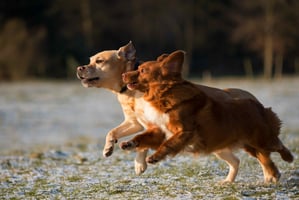Border Collies are a popular breed of dog, but they can have a tendency to bite or nip. This...
How to Help Your Reactive Dog Find Calm
Dealing with a reactive dog can be a challenge. It can be difficult to know how to help your pup find the inner peace and calm they need. Fortunately, there are steps you can take to help your reactive dog find calm. This article will discuss the most effective strategies for helping your dog find peace and relaxation.
Understanding Your Dog's Reactivity
The first step in helping your reactive dog find calm is to understand what is causing their reactivity. Reactive dogs can be triggered by a variety of things, including loud noises, other animals, strangers, and more. It is important to take the time to observe your dog and identify their triggers so that you can better address their needs.
Once you have identified your dog's triggers, you can begin to take steps to reduce their reactivity. This may include avoiding situations that cause your dog to become reactive or providing them with a safe space when they do become reactive.
Develop a Calming Routine
Developing a calming routine can be a great way to help your reactive dog find calm. This routine should include activities that your pup enjoys and relaxes them, such as long walks, playtime, and cuddles. Additionally, you can add calming activities such as massage and aromatherapy to help your pup relax even further.
A calming routine is also a great way to bond with your pup and reinforce positive behaviors. When your pup is calm and relaxed, reward them with treats and praise. This will help to reinforce the desired behavior and create a positive association with being calm.
Provide Mental Stimulation
Mental stimulation is another important part of helping your reactive dog find calm. Mental stimulation can help your pup to stay focused and engaged, which can help to reduce their reactivity.
There are a variety of ways to provide mental stimulation for your pup. You can introduce puzzle toys and treat dispensers to keep your pup engaged and entertained. Additionally, you can also provide your pup with interactive toys such as Kongs that they can use to play and challenge themselves.
Use Calming Aids
Calming aids can also be effective in helping your reactive dog find calm. There are a variety of calming aids available, such as calming treats, supplements, and calming sprays. These aids can help to reduce your pup's stress and anxiety levels and make it easier for them to remain calm in stressful situations.
If you are unsure which calming aid is best for your pup, it is best to consult with your veterinarian for advice. Your veterinarian can recommend the best calming aid for your pup's individual needs.
Create a Safe Space
Creating a safe space for your pup is also important for helping them find calm. This can be a quiet room or area of your home where your pup can retreat when they are feeling overwhelmed or stressed. This space should be free from distractions and provide your pup with a comfortable environment where they can relax.
You can also provide your pup with a crate or kennel in their safe space. This can provide them with a sense of security and help to reduce their stress levels. Additionally, you can add calming items such as a blanket or toys to provide your pup with further comfort.
Conclusion
Helping a reactive dog find calm can be a challenge, however, there are steps you can take to make it easier. It is important to understand your pup's triggers and create a calming routine. Additionally, providing your pup with mental stimulation, calming aids, and a safe space can also help your pup find the inner peace and calm they need.



